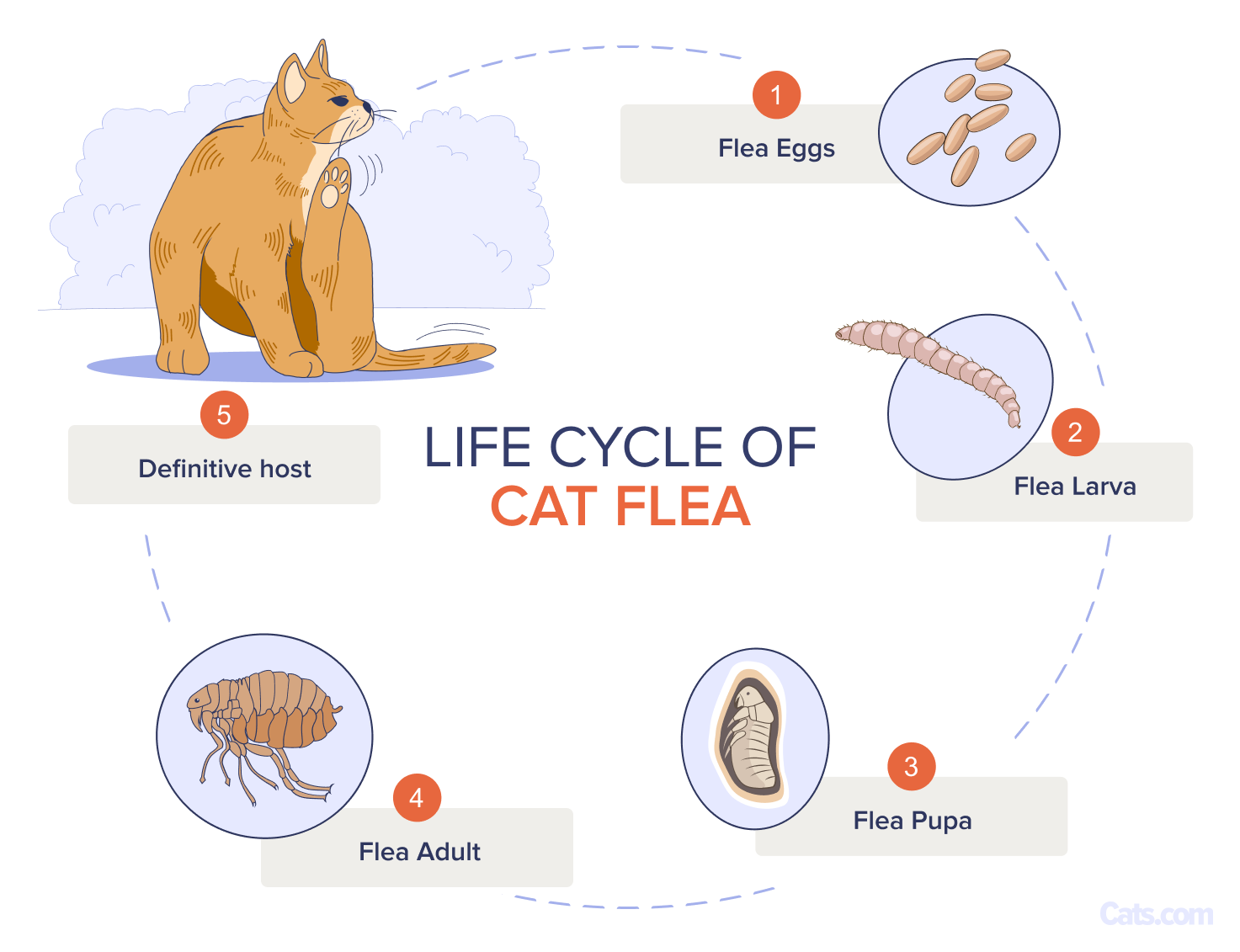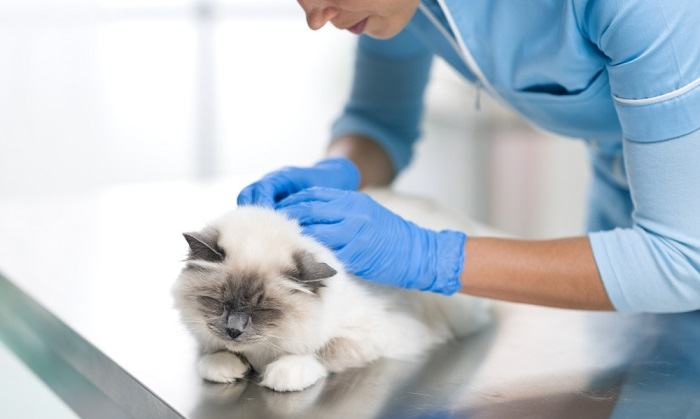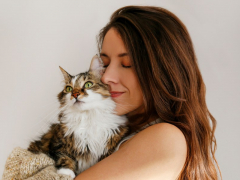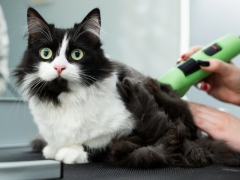
Fleas! The one word no one wants to hear. These tiny little insects make everyone in the household miserable. Fleas are not only a nuisance, making your pet itchy and uncomfortable, but they can cause serious health problems and spread diseases.
Fleas are small, wingless insects that can jump up up to thirteen inches – that’s over 100 times their length! They range in size from 1.5 to 4mm, and can be hard to see, which makes flea control rather challenging. Their flat bodies allow them to easily move in between the hairs on your cat.
Because cats are often fastidious groomers, they often swallow fleas as they clean themselves, making it hard to find them. Sometimes when I am closely examining a cat’s skin, I just see a small brown streak scurrying through the fur and wonder “was that a flea?” It can take another five minutes of searching before I see another one.
Causes of Fleas in Cats

Once you understand the complex and long life cycle of a flea, you can understand why it can be so hard to get a flea infestation under control. Because most of the flea life cycle takes place off of the host and in the environment, if one of your pets has fleas, they all likely do. Fleas can jump between hosts, so it’s easy for one pet in the household to pick up a flea when out and about. This flea can then quickly multiply in the home environment and infect other pets.
The adult fleas are only the very tip of the iceberg, accounting for only 5% of the flea population. The remaining 95% are the developing stages that live in the environment. Adult fleas live on your pet where they bite to take in blood meals, reproduce, and lay eggs. A female flea can lay up to 50 flea eggs a day! The eggs and flea dirt fall off your cat into their environment. The eggs hatch into larvae in two to twelve days.
The larvae feed on the flea dirt, grow, and molt over a period of nine to two hundred days. After their third molt, the larvae form pupae, or cocoons, where they develop into an adult flea anywhere between one week and one year, depending on environmental conditions. Once the adult fleas hatch, they can survive in the environment for up to two weeks before they need to find a host (cat, dog, person) for a blood meal.
Symptoms of Fleas in Cats
The main sign that your cat has fleas is usually that they become itchy and uncomfortable. This may present in a few different ways:
- Scratching
- Licking and excessive grooming
- Hair loss
- Red, sore, scabby skin
- Twitching skin
- Unusual behavior such as being more jumpy than normal
You may also be able to find physical evidence of the fleas on your pet.
Complications of Fleas in Cats
Fleas are not just a nuisance, they also carry parasites and diseases. A flea infestation can severely affect your cat’s overall case and may even be deadly.
Fleas Can Transmit Disease
Fleas are the intermittent host to the tapeworm Dipylidium caninum. A cat with fleas will likely ingest a few fleas while grooming. The tapeworm will mature inside the cat’s digestive tract where it steals nutrients from its host.
Fleas can also transmit Yersinia pestis, the bacteria that causes Bubonic Plague. Although we think of the plague as being a disease of the past, it can still be found in the Southwest United States. Fleas are thought to be a vector for another parasite in cats. Hemotropic Mycoplasma spp. are bacteria that infect red blood cells of cats. The infection of the bacteria on the red blood cells causes rapid destruction of the cells and severe anemia that can lead to death.
Anemia
Cats with heavy flea infestations may develop anemia. The fleas feed on blood from the host. If there are enough adult fleas feeding, there can be significant blood loss. Young kittens are at a higher risk than adult cats for severe anemia because of their smaller blood volume. Signs of anemia include weakness, lethargy, and pale gums.
Flea Allergies
Many cats develop a hypersensitivity reaction to flea saliva, resulting in flea allergy dermatitis. Cats who suffer from flea allergy dermatitis are intensely itchy. They may develop small bumps throughout their body, sores and bald spots from constant licking and scratching, and secondary skin infections. They may develop feline eosinophilic granuloma complex in which open sores develop on the skin and in the mouth of cats.
Cats with flea allergies are so sensitive that the bite of just one flea can cause a severe reaction. In these sensitive cats, year round flea prevention is especially important.
Diagnosis of Fleas in Cats

Fleas can be difficult to spot, but there is usually evidence of flea dirt, often around the base of the tail
Fleas are small, but you can find them, or evidence of them, on an infected cat. If you suspect your cat has flea problems, start by looking along the back, just above the tail head. This is the most common place fleas like to live on a cat. Use a flea comb, which is a small comb with fine and closely spaced teeth, to comb through the fur. If you find a flea, you have your answer.
However, if all you have are small black specks, shake those specks onto a white paper towel or piece of gauze. Run water over the crusts. If they turn a rusty red color, you have flea dirt. Flea dirt is the feces of fleas which is mainly digested blood. The blood is what causes the flea dirt to change to a reddish color when it gets wet. Another identifying characteristic of flea dirt is that it is often in the shape of a C.
If your cat has flea dirt, your cat has fleas.
Treating Fleas in Cats
Although it’s called the cat flea, these creatures will happily feed on other pets in the household, including dogs and rabbits. Therefore all pets in the household should be treated if you find fleas on one pet – and also the home environment. In order to break the flea life cycle, it is advised to treat for a minimum of three consecutive months.
There are a number of flea treatments for cats available over the counter and by prescription, including oral products, topicals (spot ons), and flea collars. Speak to your veterinarian about a flea control product that will suit you and your cat.
Topical products are easy to apply. Examples include Frontline Gold and Revolution, which are both very safe products that will kill fleas for a month. Bravecto is another topical product for use in cats that kills fleas for three months. If your cat likes treats, Credelio is a chewable treatment that lasts for one month. Capstar is another chewable tablet that starts killing adult fleas within an hour. The disadvantage is that Capstar only kills fleas for one day.
In a lot of cases, treating your cat for three months with a veterinary recommended product that kills adult fleas for a month and contains an insect growth regulator – which prevents more eggs from hatching – will be enough to control most flea infestations. But don’t forget, there are still eggs, flea larvae, and pupae in the environment.
Washing your pet’s bedding in hot water is often enough to kill eggs and fleas in the larval stage. The pupal stage is the safest stage for the flea in development and is almost impossible to kill. Vacuuming your carpets daily will remove any pupa from the environment. Make sure you empty your vacuum canister immediately after vacuuming, seal the garbage bag, and put the vacuum bag outside so that the pupae can’t hatch and crawl out of the vacuum, only to re-infest your cat. Environmental treatments, such as room sprays can also help kill adult fleas.
If you are unsure if a product is safe for your cat, always call your veterinarian before applying. Before applying a topical flea product, read the label carefully. Some of the products that are safe for dogs contain high levels of permethrins, an insecticide that can cause neurologic effects in cats, including tremors, seizures, and death.
Although there are lots of safe and effective products to treat fleas, there are also many treatments that do not work. Feeding your pet garlic, brewer’s yeast, tobacco, apple cider vinegar, or other “natural” remedies are not only ineffective but can also be harmful to your cat.
How To Prevent Fleas in Cats
Treating a flea infestation is a lot of work, but preventing fleas is easy. If used regularly, the topical treatments I discussed earlier (Frontline Gold, Revolution, and Bravecto) kill fleas on your cat within hours, before they have a chance to feed and lay eggs, saving you and your pet months of discomfort.
Capstar is a good preventative if your cat may have had limited contact with another animal with fleas, such as at the groomer. Capstar works quickly to kill the adult fleas before they have a chance to lay eggs and infest your kitty.
Frequently Asked Questions
Can a person get fleas from a cat?
Yes, a person can get fleas from a cat. Fleas will feed on almost any mammal. However, the common cat flea prefers to live on dogs and cats and will only bite people if they have no other options.
For example, if your cat has a very heavy flea infestation and there is no more space for the fleas, the fleas may start to bite you. Or if there was a cat in the house previously that had fleas and left eggs in the carpet, they may hatch and bite you because there are no dogs or cats to feed on.
How do you get rid of fleas on a cat?
The best way to treat fleas is to use a safe and effective flea product that kills fleas and sterilizes the eggs fleas lay.
Many products available through your veterinarian will start to kill fleas within hours of applying and will continue to kill them for a month. In order to get the flea infestation under control, it takes a minimum of three consecutive months.
Do cats act weird when they have fleas?
Many cats with fleas will have a change in behavior. When fleas bite cats, the skin becomes very itchy. You may see your cat aggressively licking and grooming, they may be hiding more, or acting more agitated because they are uncomfortable.
Do I need to treat my indoor cat for fleas?
If your cat is strictly indoors and never has any contact with an animal that goes outside, they are unlikely to get fleas. However, it can still happen. Flea pupae can live in the environment for almost a year and hatch when the environmental conditions are right, so your cat could pick up fleas without having to leave the house.
If you have more than one pet and if one pet has fleas, assume they all do. Treat all pets in the household, even your kitty that never goes outside.
Where do fleas hide on a cat?
Fleas can be found anywhere on a cat’s body, however they like to live just above the tail. You may have an easier time seeing them on your cat’s abdomen where the hair coat is often thinner.
In some cats, you may never see a flea because they will groom themselves and swallow the fleas. If your cat is suddenly really itchy and excessively scratching or grooming and you don’t see any fleas, look for flea dirt, little black C-shaped flakes in the fur. The flea dirt will turn a rusty red color when wet.








Fleas can be deterred WELL with the simple addition of NUTRITIONAL YEAST to their food. sprinkle atop, and they eat it up. The high B vitamin content discourages FLEAS-‘they don’t like the taste of their blood’. dunno WHY exactly but it tastes like parmesan cheese, is good for YOU too, and dogs and cats get NO fleas again after they are removed. GREAT prevention. I have a friend who did nothing but this and the fleas left the dogs. Good for them too! They did have to spray the house rugs though:( to get them out of the house!
My cat picked up fleas from another home that we own. I take. it that one of us
humans carried them in. He is wearing a Seresto collar that is new. I have worked for 2 weeks given him Capstar pills, combing him with a flea comb, spraying the
house with Ortho indoor spray for fleas. We are going to set off bombs tomorrow
in our Ohio house and have already set off the bombs in Ky.. Is it safe for me to give him drops on his neck? What should I do?
Hey there! Sounds like you’re doing a good job of treating both your cat and the environment. Regarding using a topical as well as the Seresto collar, I would recommend talking with your vet to see if the particular topical treatment is appropriate for use alongside the collar. Wishing you and your cat all the best!
I am curious to know what people did about cat fleas before all these products were available? Is there any natural treatment against fleas?
Mandi, that’s a fantastic question. I had to do a little searching to get an answer for you, and it seems that chemical-based treatments have been the leading approach back into the early 1900s, when homes were sometimes fumigated to destroy flea infestations. Salt was also used as a desiccant, though this is not always effective. Pets were either removed from the home and/or treated with a derris powder or soap. Derris is a plant that contains the insecticide rotenone, which continued to be used in flea and mite treatments for cats into, it seems, the early 2000s. Information on when and how it was phased out is scarce. A 1915 guide recommends rubbing mothballs (naphthalene) into cats’ fur but notes that it “slightly sickened the cats for two days”…not good. Modern flea treatments as we know them today date back to the 1990s with the introduction of insect growth regulators. Natural flea treatments include beneficial nematodes, which are highly effective for outdoor flea control, and diatomaceous earth, which effectively kills adult fleas on your cat’s body but won’t destroy eggs in the environment. Bathing and combing, of course, remains a natural and non-invasive option that effectively removes ants and eggs from your cat’s body to stop itching for a while while you treat the environment.
Hope this helps!
see my comment about nutritional yeast!:)